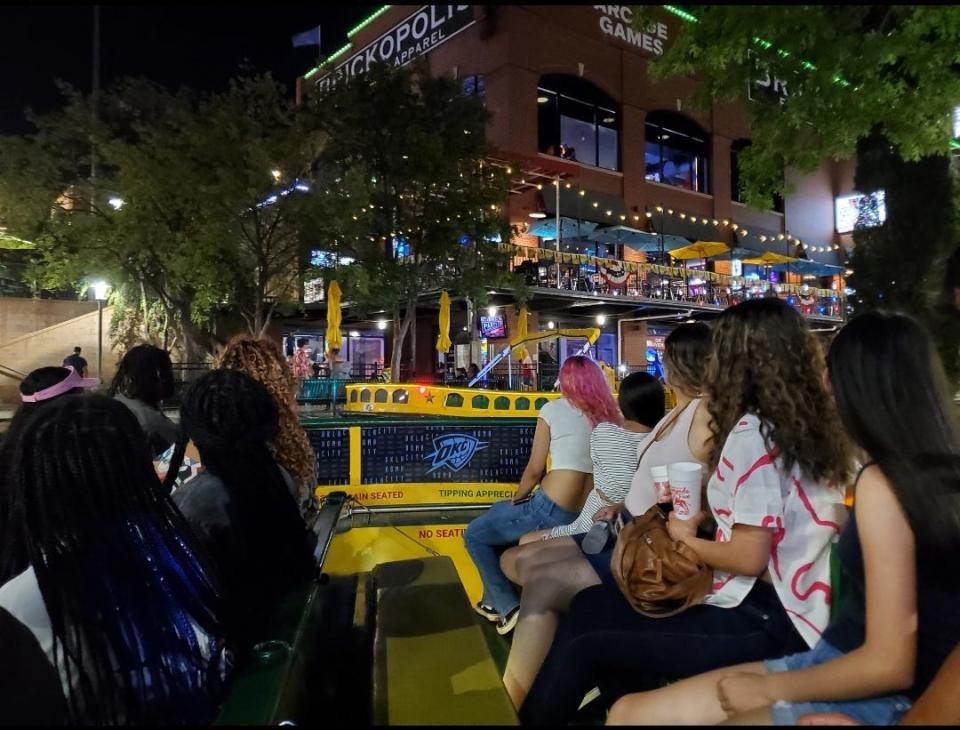Of the nine projects pitched for Oklahoma City’s original 1993 MAPS program, the idea of building a “canal” in Bricktown came with little logic or reason in a town that previously stuck to a utilitarian approach to infrastructure.
Tuesday, July 2, marks the 25th anniversary of the canal, a chance to look back on why it was built, its impact on Bricktown and Oklahoma City, and the challenges and opportunities ahead along a waterway that goes nowhere.
Before MAPS, downtown was hardly a place where locals or visitors wanted to spend much time. Only one hotel was around to provide visitors with a place to stay. Nightlife was to be found elsewhere. The only attraction was the Myriad Gardens, which opened in 1988.
The exception was to be found in Bricktown, an entertainment district that got its start in the early 1980s and was home to a handful of restaurants and a couple of bars. It wasn’t much, but in a downtown that city council members had recently declared dead, it was the best thing going.
Voters were told they could change the downward spiral of their city by investing a five-year, penny sales tax to build a new downtown library, restore the river that divided north and south Oklahoma City, renovate the Civic Center Music Hall and Myriad Convention Center, and build a ballpark and canal in Bricktown.
The canal starts just east of the BNSF Railway viaduct where it continues between a series of early 1900s brick warehouses. As it turns south into Lower Bricktown, the impact of the waterway is evident with the emergence of Brickopolis and a miniature golf course.
Lower Bricktown, developed a few years after the opening of the canal, added a 16-screen theater, bowling alley, shops and restaurants to the mix. The final third of canal ends in a park-like setting that is home to the Land Run Monument and Chickasaw Plaza.
More than 138,000 people paid to ride the water taxis along the canal. The operation is by Chad Huntington, one of the original drivers on opening day for the canal and is a dedicated Bricktown booster.
Over the past few years, Huntington has transformed the taxis into floating murals by local artists. He routinely books concert cruises and has continued the practice started by water taxi founder Bob Bekoff of training taxi captains to share a mix of history and details of local attractions with passengers.
Surrounded by locals and tourists on a water taxi ride Friday night, the tour reveals sights, sounds and smells (Mickey Mantle Steakhouse in particular) that together create an exciting chance to experience it all floating along the canal.
Some of the city’s more ambitious public art displays are located along the waterway, most notably the Centennial Land Run Monument, a sprawling bronze sculpture consisting of 45 heroic size figures commemorating the opening of the Unassigned Land with the Land Run of 1889.
The waiting area for the water taxis is home to “Inclined,” a bronze sculpture that is a reference to the African American cultural heritage of Bricktown and Deep Deuce. At the Chickasaw Plaza, a sculpture and markers tell tribe’s history and land loss following the Indian Removal Act and Trail of Tears.
Construction is nearing completion on the next highly anticipated addition to the canal with The Truck Yard. The venue will include a restaurant and bar, food truck court, dog-friendly beer garden, outdoor games, public art and live music. It’s a good transition between the park, nearby Bass Pro Shops and Lower Bricktown.
The city’s investment in the canal can be seen at the Oklahoma Avenue bridge over the canal where a much-needed elevator is under construction. Unfortunately, other parts of the canal are showing the wear and tear of its 25 years.
An existing elevator to the canal from the plaza overlook along Mickey Mantle Drive was not working Friday night though its doors stayed open throughout the evening. A railing was missing from the adjoining stairway. Elsewhere along the canal, one can see crumbling bits of concrete and dislocated walkway pavers.
Dozens of lights were dark along the south half of the canal, an issue that isn’t new and yet one must wonder why the problem persists. The darkness makes the park a somewhat dangerous proposition for those choosing to stroll along the waterway. Half of the up-lighting is out at the Land Run Monument. A picturesque waterfall in the heart of the park area is dry.
The ongoing draw for locals and tourists alone shows the value of the waterway. And private investment along the canal appears to be far from done. The Oklahoma Opry is raising $6.2 million for its headquarters and performance hall at 19 E California Ave.
California developer Scot Matteson is promoting plans to build the biggest addition yet to the district with construction set to start later this year on a $1.5 billion, four-tower development within walking distance of the canal.
The canal remains a waterway to nowhere, but from the start, it wasn’t about the destination but rather the goal of making Oklahoma City a source of pride.
“The canal helped transform Oklahoma City from a place nobody wanted to visit to a place people go out of their way to experience,” Huntington said. “In 1999, our guests were almost exclusively locals trying to see what the fuss was about, and now we speak daily to visitors from all over the world.”

This article originally appeared on Oklahoman: The Bricktown Canal at 25: OKC’s image transformed with waterway
Source Agencies


